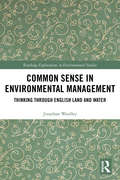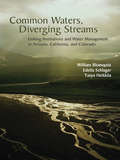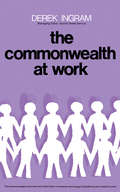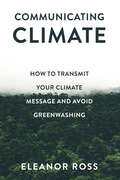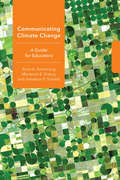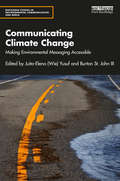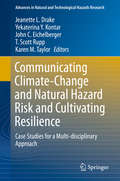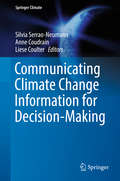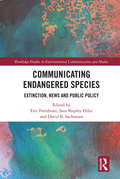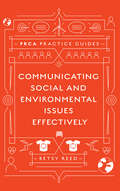- Table View
- List View
Common Sense in Environmental Management: Thinking Through English Land and Water (Routledge Explorations in Environmental Studies)
by Jonathan WoolleyCommon Sense in Environmental Management examines common sense not in theory, but in practice. Jonathan Woolley argues that common sense as a concept is rooted in English experiences of landscape and land management and examines it ethnographically - unveiling common sense as key to understanding how British nature and public life are transforming in the present day. Common sense encourages English people to tacitly assume that the management of land and other resources should organically converge on a consensus that yields self-evident, practical results. Furthermore, the English then tend to assume that their own position reflects that consensus. Other stakeholders are not seen as having legitimate but distinct expertise and interests – but are rather viewed as being stupid and/or immoral, for ignoring self-evident, pragmatic truths. Compromise is therefore less likely, and land management practices become entrenched and resistant to innovation and improvement. Through a detailed ethnographic study of the Norfolk Broads, this book explores how environmental policy and land management in rural areas could be more effective if a truly common sense was restored in the way we manage our shared environment. Using academic and lay deployments of common sense as a route into the political economy of rural environments, this book will be of great interest to scholars and students of socio-cultural anthropology, sociology, human geography, cultural studies, social history, and the environmental humanities.
Common Sense in Environmental Management: Thinking Through English Land and Water (Routledge Explorations in Environmental Studies)
by Jonathan WoolleyCommon Sense in Environmental Management examines common sense not in theory, but in practice. Jonathan Woolley argues that common sense as a concept is rooted in English experiences of landscape and land management and examines it ethnographically - unveiling common sense as key to understanding how British nature and public life are transforming in the present day. Common sense encourages English people to tacitly assume that the management of land and other resources should organically converge on a consensus that yields self-evident, practical results. Furthermore, the English then tend to assume that their own position reflects that consensus. Other stakeholders are not seen as having legitimate but distinct expertise and interests – but are rather viewed as being stupid and/or immoral, for ignoring self-evident, pragmatic truths. Compromise is therefore less likely, and land management practices become entrenched and resistant to innovation and improvement. Through a detailed ethnographic study of the Norfolk Broads, this book explores how environmental policy and land management in rural areas could be more effective if a truly common sense was restored in the way we manage our shared environment. Using academic and lay deployments of common sense as a route into the political economy of rural environments, this book will be of great interest to scholars and students of socio-cultural anthropology, sociology, human geography, cultural studies, social history, and the environmental humanities.
Common Waters, Diverging Streams: Linking Institutions and Water Management in Arizona, California, and Colorado
by William Blomquist Edella Schlager Tanya HeikkilaThis book is a firsthand investigation into water management in a fast-growing region of the arid American West. It presents three states that have adopted the conjunctive management of groundwater and surface water to make resources go further in serving people and the environment. Yet conjunctive management has followed a different history, been practiced differently, and produced different outcomes in each state. The authors question why different results have emerged from neighbors trying to solve similar problems with the same policy reform. Common Waters, Diverging Streams makes several important contributions to policy literature and policymaking. The first book on conjunctive water management, it describes how the policy came into existence, how it is practiced, what it does and does not accomplish, and how institutional arrangements affect its application. A second contribution is the book's clear and persuasive links between institutions and policy outcomes. Scholars often declare that institutions matter, but few articles or books provide an explicit case study of how policy linkages work in actual practice. In contrast, Blomquist, Schlager, and Heikkila show how diverging courses in conjunctive water management can be explained by state laws and regulations, legal doctrines, the organizations governing and managing water supplies, and the division of authority between state and local government. Not only do these institutional structures make conjunctive management easier or harder to achieve, but they influence the kinds of problems people try to solve and the purposes for which they attempt conjunctive management.
Common Waters, Diverging Streams: Linking Institutions and Water Management in Arizona, California, and Colorado
by William Blomquist Edella Schlager Tanya HeikkilaThis book is a firsthand investigation into water management in a fast-growing region of the arid American West. It presents three states that have adopted the conjunctive management of groundwater and surface water to make resources go further in serving people and the environment. Yet conjunctive management has followed a different history, been practiced differently, and produced different outcomes in each state. The authors question why different results have emerged from neighbors trying to solve similar problems with the same policy reform. Common Waters, Diverging Streams makes several important contributions to policy literature and policymaking. The first book on conjunctive water management, it describes how the policy came into existence, how it is practiced, what it does and does not accomplish, and how institutional arrangements affect its application. A second contribution is the book's clear and persuasive links between institutions and policy outcomes. Scholars often declare that institutions matter, but few articles or books provide an explicit case study of how policy linkages work in actual practice. In contrast, Blomquist, Schlager, and Heikkila show how diverging courses in conjunctive water management can be explained by state laws and regulations, legal doctrines, the organizations governing and managing water supplies, and the division of authority between state and local government. Not only do these institutional structures make conjunctive management easier or harder to achieve, but they influence the kinds of problems people try to solve and the purposes for which they attempt conjunctive management.
Common Wealth: Economics for a Crowded Planet
by Jeffrey SachsThis is a book about how we should address the great, and interconnected, global challenges of the twenty-first century. Our task, Sachs argues, is to achieve truly sustainable development, by which he means finding a global course which enables the world to benefit from the spread of prosperity while ensuring that we don't destroy the eco-systems which keep us alive and our place in nature which helps sustain our values. How do we move forward together, benefitting from our increasing technological mastery, avoiding the terrible dangers of climate change, mass famines, violent conflicts, population explosions in some parts of the world and collapses in others, and world-wide pandemic diseases? In answering these questions, Sachs shows that there are different ways of managing the world's technology, resources and politics from those currently being followed, and that it should be possible to adopt policies which reflect long-term and co-operative thinking instead of, as currently, disregard for others and ever-increasing barriers to solving the problems which we collectively face. It is a book which appeals equally to both head and heart, and one which no globally thinking person can ignore.
The Common Worlds of Children and Animals: Relational Ethics for Entangled Lives (Routledge Spaces of Childhood and Youth Series)
by Veronica Pacini-Ketchabaw Affrica TaylorThe lives and futures of children and animals are linked to environmental challenges associated with the Anthropocene and the acceleration of human-caused extinctions. This book sparks a fascinating interdisciplinary conversation about child–animal relations, calling for a radical shift in how we understand our relationship with other animals and our place in the world. It addresses issues of interspecies and intergenerational environmental justice through examining the entanglement of children’s and animal’s lives and common worlds. It explores everyday encounters and unfolding relations between children and urban wildlife. Inspired by feminist environmental philosophies and indigenous cosmologies, the book poses a new relational ethics based upon the small achievements of child–animal interactions. It also provides an analysis of animal narratives in children’s popular culture. It traces the geo-historical trajectories and convergences of these narratives and of the lives of children and animals in settler-colonised lands. This innovative book brings together the fields of more-than-human geography, childhood studies, multispecies studies, and the environmental humanities. It will be of interest to students and scholars who are reconsidering the ethics of child–animal relations from a fresh perspective.
The Common Worlds of Children and Animals: Relational Ethics for Entangled Lives (Routledge Spaces of Childhood and Youth Series)
by Veronica Pacini-Ketchabaw Affrica TaylorThe lives and futures of children and animals are linked to environmental challenges associated with the Anthropocene and the acceleration of human-caused extinctions. This book sparks a fascinating interdisciplinary conversation about child–animal relations, calling for a radical shift in how we understand our relationship with other animals and our place in the world. It addresses issues of interspecies and intergenerational environmental justice through examining the entanglement of children’s and animal’s lives and common worlds. It explores everyday encounters and unfolding relations between children and urban wildlife. Inspired by feminist environmental philosophies and indigenous cosmologies, the book poses a new relational ethics based upon the small achievements of child–animal interactions. It also provides an analysis of animal narratives in children’s popular culture. It traces the geo-historical trajectories and convergences of these narratives and of the lives of children and animals in settler-colonised lands. This innovative book brings together the fields of more-than-human geography, childhood studies, multispecies studies, and the environmental humanities. It will be of interest to students and scholars who are reconsidering the ethics of child–animal relations from a fresh perspective.
Commonsense in Nuclear Energy (Routledge Revivals)
by Fred Hoyle Geoffrey HoyleOriginally published in 1979, written at a time when the world stood on the brink of (another) energy crisis, this book argued that an alternative primary fuel had to be found and that the answer lay in the exploitation of nuclear fission. The book sought to dispel the anxieties of environmentalists by correcting what the authors felt were basic misconceptions about nuclear energy. The book distinguishes carefully between nuclear energy and nuclear explosions, as the authors believed that it was the confusion between these two very different things which lies at the root of most opposition to nuclear energy. The Relevant facts concerning nuclear energy are presented in a straightforward way and the case made that nuclear energy can be clean and safe. The book includes a discussion of the storage of nuclear waste and the safety record of the nuclear industry.
Commonsense in Nuclear Energy (Routledge Revivals)
by Fred Hoyle Geoffrey HoyleOriginally published in 1979, written at a time when the world stood on the brink of (another) energy crisis, this book argued that an alternative primary fuel had to be found and that the answer lay in the exploitation of nuclear fission. The book sought to dispel the anxieties of environmentalists by correcting what the authors felt were basic misconceptions about nuclear energy. The book distinguishes carefully between nuclear energy and nuclear explosions, as the authors believed that it was the confusion between these two very different things which lies at the root of most opposition to nuclear energy. The Relevant facts concerning nuclear energy are presented in a straightforward way and the case made that nuclear energy can be clean and safe. The book includes a discussion of the storage of nuclear waste and the safety record of the nuclear industry.
The Commonwealth at Work: The Commonwealth and International Library: Commonwealth Affairs Division
by Derek IngramThe Commonwealth at Work examines the nature of the widely varied machinery which is at work within the Commonwealth trying to promote cooperation between the member countries on all levels and in many different spheres, including higher education. It describes the Commonwealth Secretariat and its functions in theory and practice, along with the Commonwealth Foundation, the Commonwealth Parliamentary Association, and the Commonwealth's economic machinery, including the Commonwealth Liaison Committee and the Commonwealth Development Corporation. This book consists of 10 chapters and opens with a discussion on how the Commonwealth machinery that exists can grow and be more effectively used for the good of the 800 million people of all the member nations, as well as the consultation and cooperation that occur among those nations. The rRegional groupings in Asia, Africa, and the Caribbean are considered, together with the Heads of Government conferences. The following chapters focus on the functions of the Commonwealth Secretariat and Commonwealth's relationship with the United Nations; the Commonwealth Foundation; the Commonwealth Parliamentary Association; and the Commonwealth Institute and its relation with the Royal Commonwealth Society. Some areas of cooperation among Commonwealth states are examined, including higher education, medicine, and communication and the arts. This monograph will be of interest to political scientists, politicians, government officials, and students and practitioners in the field of international relations.
Communicating Climate: How to Transmit Your Climate Message and Avoid Greenwashing
by Eleanor RossBusinesses can no longer afford to stick their heads in the sand. The time to act is now. Cities are becoming unliveable, triggering migration patterns and resource shortages, in turn causing civil wars and conflict. Natural disasters like hurricanes and wildfires are simply becoming known as ‘weather’, and biodiversity is disappearing from our very eyes. The fact is, we won’t have a planet to do business on if we don’t act now. Climate change is already hitting our bottom lines, as the cost of natural resources, energy, and manpower skyrocket. It’s predicted to cost the world $20 trillion a year if we can’t keep global heating to less than 2 degrees Celsius. This is a book about communicating climate: how to achieve cut-through, whether you’re trying to inspire your clients, get your shareholders on board, or simply showcase your progress in greening the world. This is not a greenwashing manual. It is about achieving balance in a world where we need to reduce our consumption, but also keep businesses functioning, just in a cleaner, greener, way. Communicating Climate is packed with case studies, examples, tips and interviews from those leading the charge towards sustainability.
Communicating Climate: How to Transmit Your Climate Message and Avoid Greenwashing
by Eleanor RossBusinesses can no longer afford to stick their heads in the sand. The time to act is now. Cities are becoming unliveable, triggering migration patterns and resource shortages, in turn causing civil wars and conflict. Natural disasters like hurricanes and wildfires are simply becoming known as ‘weather’, and biodiversity is disappearing from our very eyes. The fact is, we won’t have a planet to do business on if we don’t act now. Climate change is already hitting our bottom lines, as the cost of natural resources, energy, and manpower skyrocket. It’s predicted to cost the world $20 trillion a year if we can’t keep global heating to less than 2 degrees Celsius. This is a book about communicating climate: how to achieve cut-through, whether you’re trying to inspire your clients, get your shareholders on board, or simply showcase your progress in greening the world. This is not a greenwashing manual. It is about achieving balance in a world where we need to reduce our consumption, but also keep businesses functioning, just in a cleaner, greener, way. Communicating Climate is packed with case studies, examples, tips and interviews from those leading the charge towards sustainability.
Communicating Climate Change: A Guide for Educators (Cornell Series in Environmental Education)
by Anne K. Armstrong Marianne E. Krasny Jonathon P. SchuldtEnvironmental educators face a formidable challenge when they approach climate change due to the complexity of the science and of the political and cultural contexts in which people live. There is a clear consensus among climate scientists that climate change is already occurring as a result of human activities, but high levels of climate change awareness and growing levels of concern have not translated into meaningful action. Communicating Climate Change provides environmental educators with an understanding of how their audiences engage with climate change information as well as with concrete, empirically tested communication tools they can use to enhance their climate change program.Starting with the basics of climate science and climate change public opinion, Armstrong, Krasny, and Schuldt synthesize research from environmental psychology and climate change communication, weaving in examples of environmental education applications throughout this practical book. Each chapter covers a separate topic, from how environmental psychology explains the complex ways in which people interact with climate change information to communication strategies with a focus on framing, metaphors, and messengers. This broad set of topics will aid educators in formulating program language for their classrooms at all levels. Communicating Climate Change uses fictional vignettes of climate change education programs and true stories from climate change educators working in the field to illustrate the possibilities of applying research to practice. Armstrong et al, ably demonstrate that environmental education is an important player in fostering positive climate change dialogue and subsequent climate change action.Thanks to generous funding from Cornell University, the ebook editions of this book are available as Open Access from Cornell Open (cornellopen.org) and other Open Access repositories.
Communicating Climate Change: Making Environmental Messaging Accessible (Routledge Studies in Environmental Communication and Media)
by Juita-Elena Wie Yusuf And Burton St. John IIIThis edited collection focuses on theoretical and applied research-based observations concerning how experts, advocates, and institutions make climate change information accessible to different audiences. Communicating Climate Change concentrates on three key elements of climate change communication – access, relevance, and understandability – to provide an overview of how these aspects allow multiple groups of stakeholders to act on climate-related information to build resilience. Featuring contributions from a wide range of scholars from across different disciplines, this book explores a multitude of different scenarios and communication methods, including social media; public opinion surveys; participatory mapping; and video. Overall, climate change communication is addressed from three different perspectives: communicating with the public; communicating for stakeholder engagement; and organizational, institutional, risk, and disaster communication. With each chapter focusing on implications and applications for practice, this book will be of great interest to students and researchers of climate change and environmental communication, as well as practitioners interested in understanding how to better engage stakeholders through climate change-related communication.
Communicating Climate Change: Making Environmental Messaging Accessible (Routledge Studies in Environmental Communication and Media)
by Juita-Elena Wie Yusuf Burton St. John IIIThis edited collection focuses on theoretical and applied research-based observations concerning how experts, advocates, and institutions make climate change information accessible to different audiences. Communicating Climate Change concentrates on three key elements of climate change communication – access, relevance, and understandability – to provide an overview of how these aspects allow multiple groups of stakeholders to act on climate-related information to build resilience. Featuring contributions from a wide range of scholars from across different disciplines, this book explores a multitude of different scenarios and communication methods, including social media; public opinion surveys; participatory mapping; and video. Overall, climate change communication is addressed from three different perspectives: communicating with the public; communicating for stakeholder engagement; and organizational, institutional, risk, and disaster communication. With each chapter focusing on implications and applications for practice, this book will be of great interest to students and researchers of climate change and environmental communication, as well as practitioners interested in understanding how to better engage stakeholders through climate change-related communication.
Communicating Climate-Change and Natural Hazard Risk and Cultivating Resilience: Case Studies for a Multi-disciplinary Approach (Advances in Natural and Technological Hazards Research #45)
by Jeanette L. Drake Yekaterina Y. Kontar John C. Eichelberger T. Scott Rupp Karen M. TaylorThis edited volume emphasizes risk and crisis communication principles and practices within the up-to the minute context of new technologies, a new focus on resiliency, and global environmental change. It includes contributions from experts from around the globe whose research, advocacy, teaching, work, or service in the natural or social sciences deals with risk communication and/or management surrounding natural and technological disasters, with a particular focus on climate change-related phenomena. Resilience and good communication are intimately linked and with climate change precipitating more numerous and onerous weather-related catastrophes, a conversation on resilience is timely and necessary. The goal is robust communities that are able to withstand the shock of disaster. Communicating well under ordinary circumstances is challenging; communicating during a crisis is extraordinarily difficult.This book is dedicated to all those who have directly or indirectly suffered the effects of climate change end extreme events with the hope that the advance of knowledge, implementation of sound science and appropriate policies and use of effective communication will help in reducing their vulnerability while also improving resilience in the face of often devastating natural and technological disasters.
Communicating Climate Change Information for Decision-Making (Springer Climate)
by Silvia Serrao-Neumann Anne Coudrain Liese CoulterThis book provides important insight on a range of issues focused on three themes; what new climate change information is being developed, how that knowledge is communicated and how it can be usefully applied across international, regional and local scales. There is increasing international investment and interest to develop and communicate updated climate change information to promote effective action. As change accelerates and planetary boundaries are crossed this information becomes particularly relevant to guide decisions and support both proactive adaptation and mitigation strategies. Developing new information addresses innovations in producing interdisciplinary climate change knowledge and overcoming issues of data quality, access and availability. This book examines effective information systems to guide decision-making for immediate and future action. Cases studies in developed and developing countries illustrate how climate change information promotes immediate and future actions across a range of sectors.
Communicating Endangered Species: Extinction, News and Public Policy (Routledge Studies in Environmental Communication and Media)
by Eric Freedman; Sara Shipley Hiles; David B. SachsmanCommunicating Endangered Species: Extinction, News, and Public Policy is a multidisciplinary environmental communication book that takes a distinctive approach by connecting how media and culture depict and explain endangered species with how policymakers and natural resource managers can or do respond to these challenges in practical terms. Extinction isn’t new. However, the pace of extinction is accelerating globally. The International Union for Conservation of Nature classifies more than 26,000 species as threatened. The causes are many, including climate change, overdevelopment, human exploitation, disease, overhunting, habitat destruction, and predators. The willingness and the ability of ordinary people, governments, scientists, nongovernmental organizations, and businesses to slow this deeply disturbing acceleration are uncertain. Meanwhile, researchers around the world are laboring to better understand and communicate the possibility and implications of extinctions and to discover effective tools and public policies to combat the threats to species survival. This book presents a history of news coverage of endangered species around the world, examining how and why journalists and other communicators wrote what they did, how attitudes have changed, and why they have changed. It draws on the latest research by chapter authors who are a mix of social scientists, communication experts, and natural scientists. Each chapter includes a mass media and/or cultural aspect. This book will be essential reading for students, natural resource managers, government officials, environmental activists, and academics interested in conservation and biodiversity, environmental communication and journalism, and public policy.
Communicating Endangered Species: Extinction, News and Public Policy (Routledge Studies in Environmental Communication and Media)
by Eric Freedman Sara Shipley Hiles David B. SachsmanCommunicating Endangered Species: Extinction, News, and Public Policy is a multidisciplinary environmental communication book that takes a distinctive approach by connecting how media and culture depict and explain endangered species with how policymakers and natural resource managers can or do respond to these challenges in practical terms. Extinction isn’t new. However, the pace of extinction is accelerating globally. The International Union for Conservation of Nature classifies more than 26,000 species as threatened. The causes are many, including climate change, overdevelopment, human exploitation, disease, overhunting, habitat destruction, and predators. The willingness and the ability of ordinary people, governments, scientists, nongovernmental organizations, and businesses to slow this deeply disturbing acceleration are uncertain. Meanwhile, researchers around the world are laboring to better understand and communicate the possibility and implications of extinctions and to discover effective tools and public policies to combat the threats to species survival. This book presents a history of news coverage of endangered species around the world, examining how and why journalists and other communicators wrote what they did, how attitudes have changed, and why they have changed. It draws on the latest research by chapter authors who are a mix of social scientists, communication experts, and natural scientists. Each chapter includes a mass media and/or cultural aspect. This book will be essential reading for students, natural resource managers, government officials, environmental activists, and academics interested in conservation and biodiversity, environmental communication and journalism, and public policy.
Communicating Environmental Patriotism: A Rhetorical History of the American Environmental Movement (Routledge Explorations in Environmental Studies)
by Anne Marie ToddEnvironmental patriotism, the belief that the national environment defines a country’s greatness, is a significant strand in twentieth century American environmentalism. This book is the first to explore the history of environmental patriotism in America through the intriguing stories of environmental patriots and the rhetoric of their speeches and propaganda, The See America First movement began in 1906 with the aim of protecting and promoting the landscapes of the American West. In 1908, Gifford Pinchot and President Theodore Roosevelt hosted the White House Conservation Conference to promote the wise use of natural resources for generations of Americans. In 1912, Pittsburgh’s smoke investigation condemned the effects of coal smoke on the city’s environment. In World War II, a massive propaganda effort mobilized millions of Americans to plant victory gardens to save resources for the war abroad. While these may not seem like crucial moments for the American environmental movement, this new history of American environmentalism shows that they are linked by patriotism. The book offers a provoking critique of environmentalists’ communication strategies and suggests patriotism as a persuasive hook for new ways to make environmental issues a national priority. This original research should be of interest to scholars of environmental communication, environmental history, American history and environmental philosophy.
Communicating Environmental Patriotism: A Rhetorical History of the American Environmental Movement (Routledge Explorations in Environmental Studies)
by Anne Marie ToddEnvironmental patriotism, the belief that the national environment defines a country’s greatness, is a significant strand in twentieth century American environmentalism. This book is the first to explore the history of environmental patriotism in America through the intriguing stories of environmental patriots and the rhetoric of their speeches and propaganda, The See America First movement began in 1906 with the aim of protecting and promoting the landscapes of the American West. In 1908, Gifford Pinchot and President Theodore Roosevelt hosted the White House Conservation Conference to promote the wise use of natural resources for generations of Americans. In 1912, Pittsburgh’s smoke investigation condemned the effects of coal smoke on the city’s environment. In World War II, a massive propaganda effort mobilized millions of Americans to plant victory gardens to save resources for the war abroad. While these may not seem like crucial moments for the American environmental movement, this new history of American environmentalism shows that they are linked by patriotism. The book offers a provoking critique of environmentalists’ communication strategies and suggests patriotism as a persuasive hook for new ways to make environmental issues a national priority. This original research should be of interest to scholars of environmental communication, environmental history, American history and environmental philosophy.
Communicating Social and Environmental Issues Effectively (PRCA Practice Guides)
by Betsy ReedAs awareness of social and environmental issues becomes more central to business and reputational success, communications and marketing professionals need to be able to make the most of opportunities to communicate effectively about these issues. This is the definitive guide to planning and delivering great communications on complex social and environmental issues. Outlining the steps needed to plan, risk-proof and execute effective communications strategies, the book provides a clear framework to help leaders, communications managers and marketing practitioners build the knowledge and skills needed to spot risks and opportunities around complex issues, such as climate change and ethical supply chains. Including real-world case studies, practical exercises and further reading, each chapter offers a beginning-to-end framework: from making the business case and mapping stakeholders, to messaging, framing relevant tactics, and then risk-assessing the plan. Whether a local authority, brand, educational institution or senior leader, this guide will equip you with all the necessary skills to make your communications effective.
Communicating Social and Environmental Issues Effectively (PRCA Practice Guides)
by Betsy ReedAs awareness of social and environmental issues becomes more central to business and reputational success, communications and marketing professionals need to be able to make the most of opportunities to communicate effectively about these issues. This is the definitive guide to planning and delivering great communications on complex social and environmental issues. Outlining the steps needed to plan, risk-proof and execute effective communications strategies, the book provides a clear framework to help leaders, communications managers and marketing practitioners build the knowledge and skills needed to spot risks and opportunities around complex issues, such as climate change and ethical supply chains. Including real-world case studies, practical exercises and further reading, each chapter offers a beginning-to-end framework: from making the business case and mapping stakeholders, to messaging, framing relevant tactics, and then risk-assessing the plan. Whether a local authority, brand, educational institution or senior leader, this guide will equip you with all the necessary skills to make your communications effective.
Communicating Sustainability
by Margaret RobertsonCommunicating Sustainability is a book of evidence-based strategies for making sustainability vivid, accessible, and comprehensible. To do this, it brings together research from a range of specialties including cognitive psychology, visual perception, communication studies, environmental design, interpretive exhibit design, interpretive signage, wayfinding, storytelling, courtroom litigation, information graphics, and graphic design to illustrate not only what approaches are effective but why they work as they do. The topic of sustainability is vast and complex. It interconnects multiple dimensions of human culture and the biosphere and involves a myriad of systems and processes, many of which are too large, too small, too fast, or too slow to see. Many people find verbal explanations about all of this too abstract or too complicated to understand, and for most people the concepts of sustainability are regarded as quirky, peripheral, and not essential to everyday life. Yet the challenges of sustainability concern the very survival of most species of life on Earth, including the human species. In order for life as we know it to survive and thrive into the future, sustainability must become broadly understood—by everyone, not just activists or specialists. This book offers tools to help make complex systems and nuanced, abstract ideas concrete and comprehensible to the broadest range of people. The goal of communication, and of this book, is to build understanding.
Communities and Livelihood Strategies in Developing Countries
by Keshav Lall MaharjanSustainability of rural communities is threatened by a plethora of factors including climate change and disasters which interact in an intricate manner in making rural people vulnerable and poor. This book is the output of empirical research on communities and livelihood strategies in developing countries. It reveals how rural communities are functioning and earning their livelihoods by making the best use of the resources, local/internal or external/new and the combination of the two to counteract the various challenges they face, with the ultimate goal of becoming resilient to local or global shocks and sustaining that resilience. Local governance is identified as crucial in ensuring sustainable livelihoods as it ensures healthy collaboration between communities, on the one hand and civil society and those communities, on the other hand, in promoting self-sustaining development trajectories. Similarly, the role of social capital is not ignored as it brings in community drive and a sense of purpose, direction and solidarity among community members which facilitates problem solving in periods of crises and disasters.
